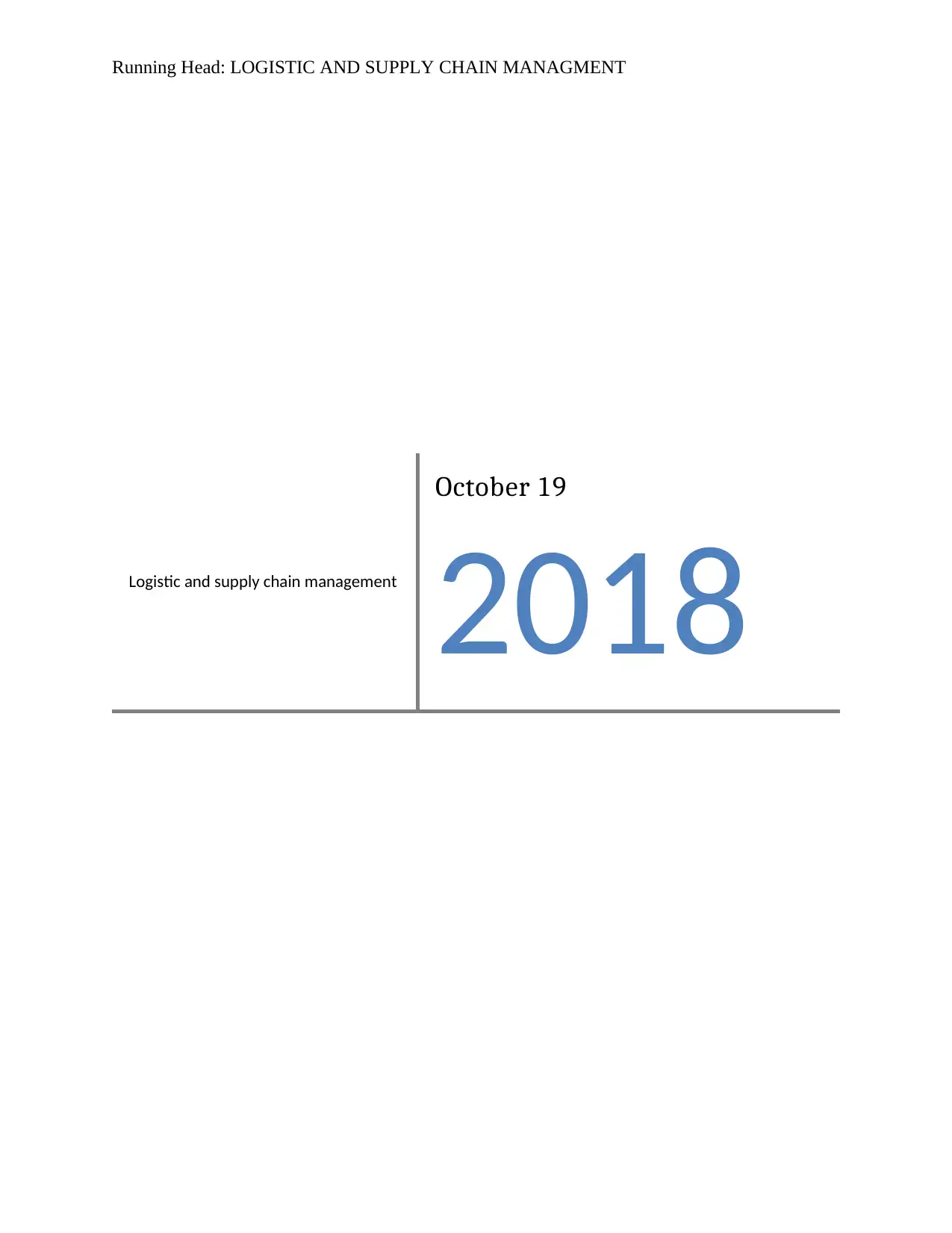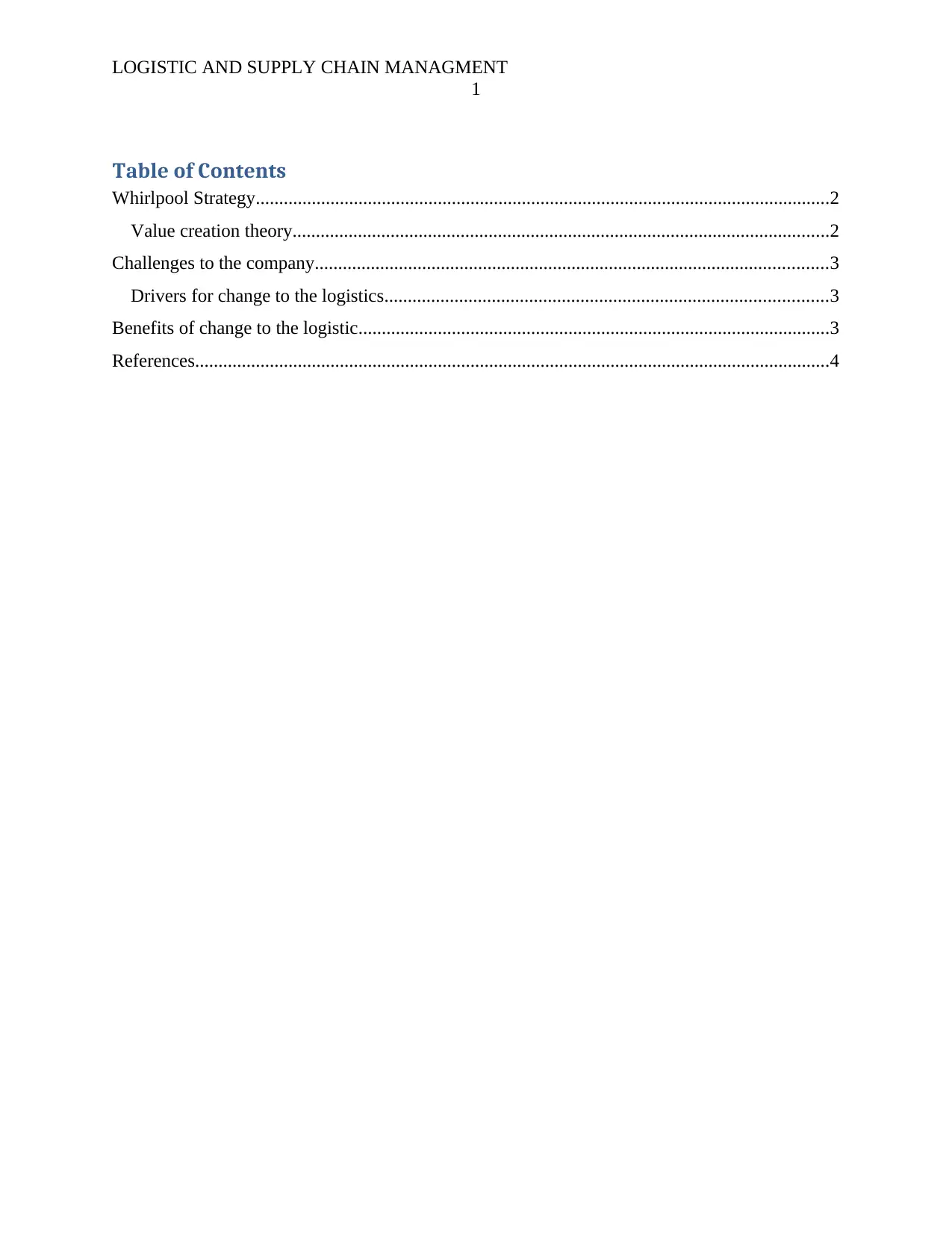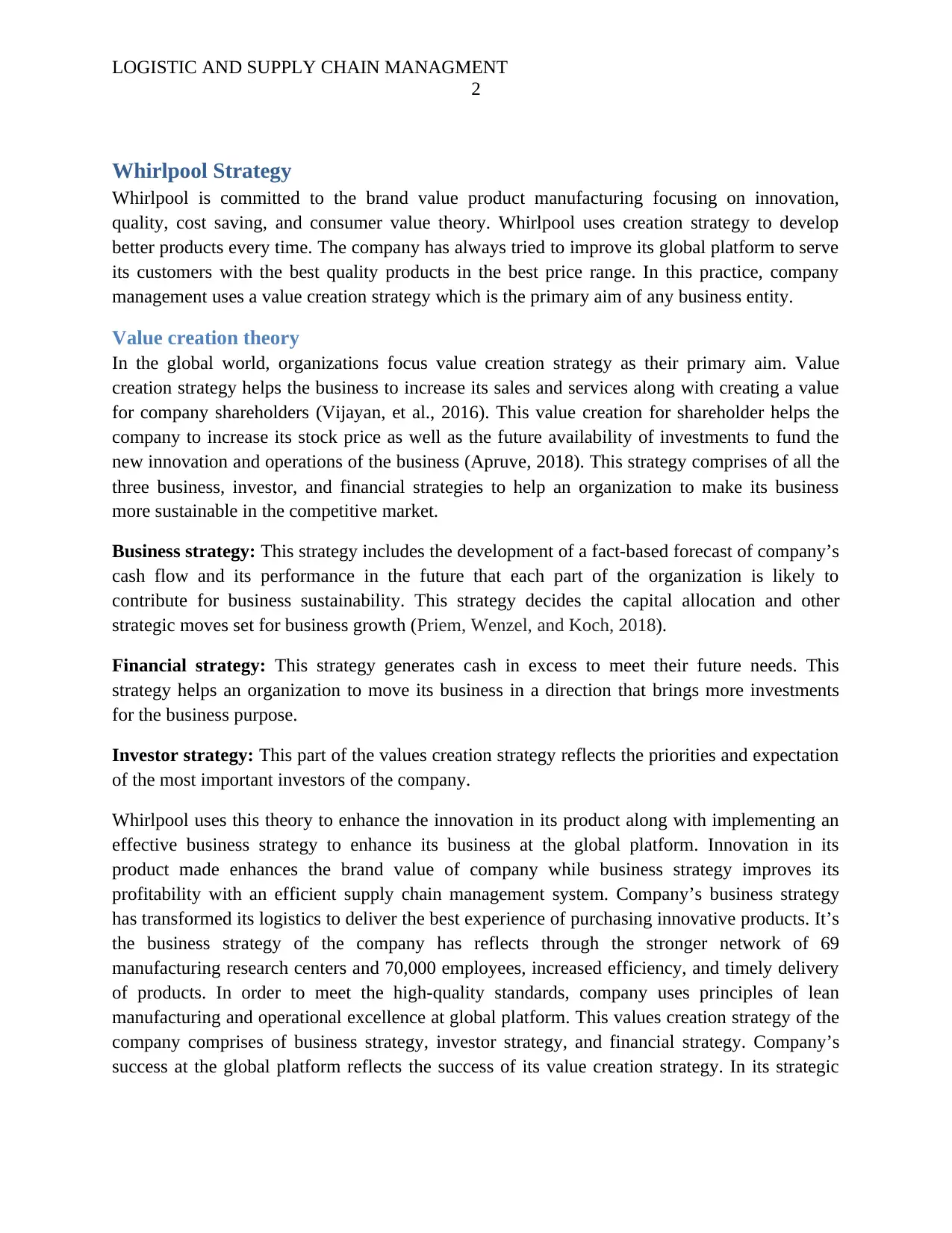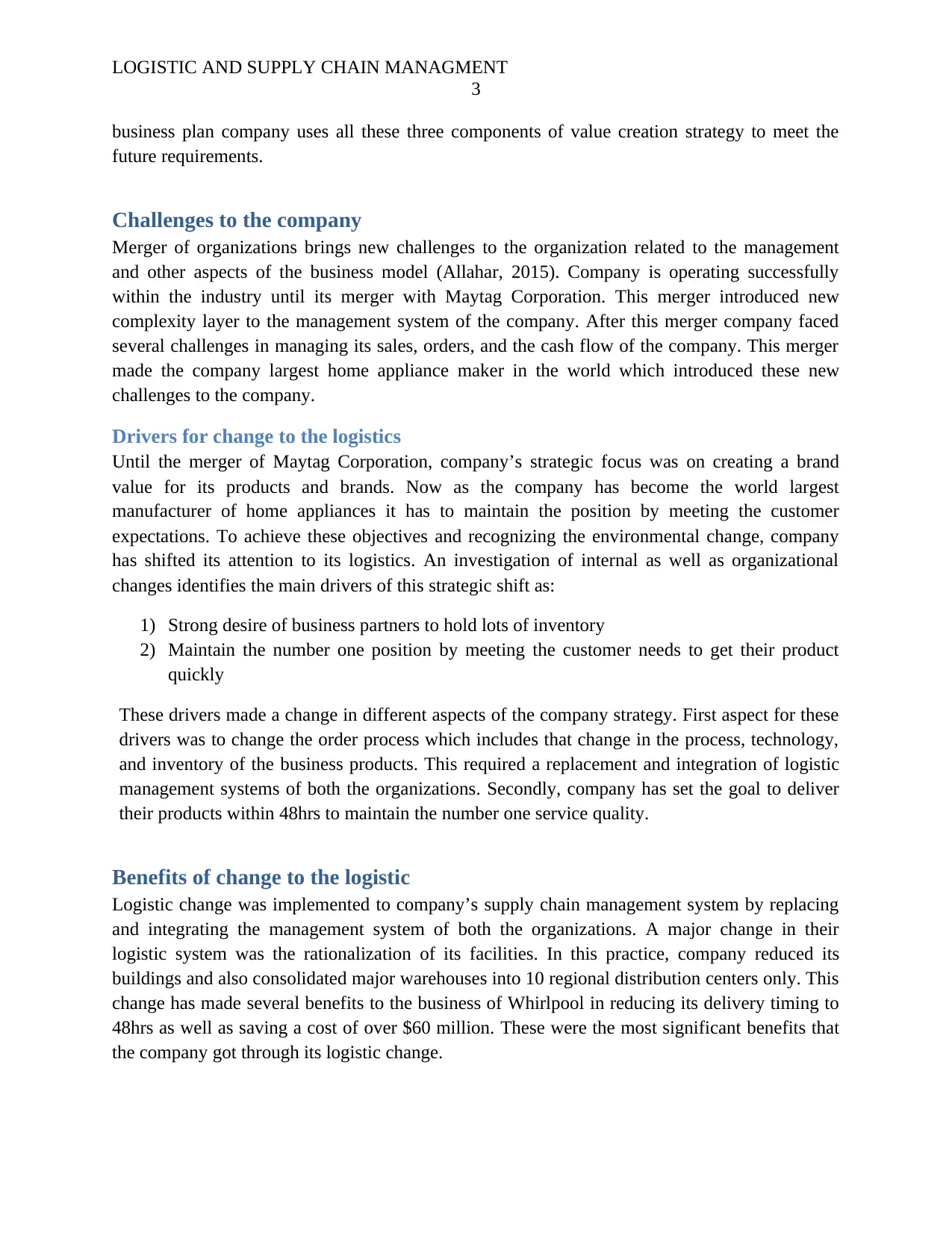MGT 322 Case Study: Whirlpool's Logistics and Supply Chain Management
VerifiedAdded on 2023/06/03
|5
|1143
|156
Case Study
AI Summary
This case study analyzes Whirlpool Corporation's logistics and supply chain management strategies. It begins with an overview of Whirlpool's commitment to value creation through product innovation, quality, and cost savings. The analysis explores the company's value creation theory, focusing on business, financial, and investor strategies. It then identifies challenges faced by the company, particularly after the merger with Maytag Corporation. The study highlights the drivers for change in logistics, including the desire to maintain a leading market position and meet customer expectations. The benefits of these changes are discussed, including reduced delivery times and cost savings achieved through facility rationalization. The case study also examines the company's strategies to manage its sales, orders, and cash flow after the merger with Maytag Corporation, which led to it becoming the world's largest home appliance maker. The document also references the company's stronger network, principles of lean manufacturing, and operational excellence.

Running Head: LOGISTIC AND SUPPLY CHAIN MANAGMENT
Logistic and supply chain management
October 19
2018
Logistic and supply chain management
October 19
2018
Paraphrase This Document
Need a fresh take? Get an instant paraphrase of this document with our AI Paraphraser

LOGISTIC AND SUPPLY CHAIN MANAGMENT
1
Table of Contents
Whirlpool Strategy...........................................................................................................................2
Value creation theory...................................................................................................................2
Challenges to the company..............................................................................................................3
Drivers for change to the logistics...............................................................................................3
Benefits of change to the logistic.....................................................................................................3
References........................................................................................................................................4
1
Table of Contents
Whirlpool Strategy...........................................................................................................................2
Value creation theory...................................................................................................................2
Challenges to the company..............................................................................................................3
Drivers for change to the logistics...............................................................................................3
Benefits of change to the logistic.....................................................................................................3
References........................................................................................................................................4

LOGISTIC AND SUPPLY CHAIN MANAGMENT
2
Whirlpool Strategy
Whirlpool is committed to the brand value product manufacturing focusing on innovation,
quality, cost saving, and consumer value theory. Whirlpool uses creation strategy to develop
better products every time. The company has always tried to improve its global platform to serve
its customers with the best quality products in the best price range. In this practice, company
management uses a value creation strategy which is the primary aim of any business entity.
Value creation theory
In the global world, organizations focus value creation strategy as their primary aim. Value
creation strategy helps the business to increase its sales and services along with creating a value
for company shareholders (Vijayan, et al., 2016). This value creation for shareholder helps the
company to increase its stock price as well as the future availability of investments to fund the
new innovation and operations of the business (Apruve, 2018). This strategy comprises of all the
three business, investor, and financial strategies to help an organization to make its business
more sustainable in the competitive market.
Business strategy: This strategy includes the development of a fact-based forecast of company’s
cash flow and its performance in the future that each part of the organization is likely to
contribute for business sustainability. This strategy decides the capital allocation and other
strategic moves set for business growth (Priem, Wenzel, and Koch, 2018).
Financial strategy: This strategy generates cash in excess to meet their future needs. This
strategy helps an organization to move its business in a direction that brings more investments
for the business purpose.
Investor strategy: This part of the values creation strategy reflects the priorities and expectation
of the most important investors of the company.
Whirlpool uses this theory to enhance the innovation in its product along with implementing an
effective business strategy to enhance its business at the global platform. Innovation in its
product made enhances the brand value of company while business strategy improves its
profitability with an efficient supply chain management system. Company’s business strategy
has transformed its logistics to deliver the best experience of purchasing innovative products. It’s
the business strategy of the company has reflects through the stronger network of 69
manufacturing research centers and 70,000 employees, increased efficiency, and timely delivery
of products. In order to meet the high-quality standards, company uses principles of lean
manufacturing and operational excellence at global platform. This values creation strategy of the
company comprises of business strategy, investor strategy, and financial strategy. Company’s
success at the global platform reflects the success of its value creation strategy. In its strategic
2
Whirlpool Strategy
Whirlpool is committed to the brand value product manufacturing focusing on innovation,
quality, cost saving, and consumer value theory. Whirlpool uses creation strategy to develop
better products every time. The company has always tried to improve its global platform to serve
its customers with the best quality products in the best price range. In this practice, company
management uses a value creation strategy which is the primary aim of any business entity.
Value creation theory
In the global world, organizations focus value creation strategy as their primary aim. Value
creation strategy helps the business to increase its sales and services along with creating a value
for company shareholders (Vijayan, et al., 2016). This value creation for shareholder helps the
company to increase its stock price as well as the future availability of investments to fund the
new innovation and operations of the business (Apruve, 2018). This strategy comprises of all the
three business, investor, and financial strategies to help an organization to make its business
more sustainable in the competitive market.
Business strategy: This strategy includes the development of a fact-based forecast of company’s
cash flow and its performance in the future that each part of the organization is likely to
contribute for business sustainability. This strategy decides the capital allocation and other
strategic moves set for business growth (Priem, Wenzel, and Koch, 2018).
Financial strategy: This strategy generates cash in excess to meet their future needs. This
strategy helps an organization to move its business in a direction that brings more investments
for the business purpose.
Investor strategy: This part of the values creation strategy reflects the priorities and expectation
of the most important investors of the company.
Whirlpool uses this theory to enhance the innovation in its product along with implementing an
effective business strategy to enhance its business at the global platform. Innovation in its
product made enhances the brand value of company while business strategy improves its
profitability with an efficient supply chain management system. Company’s business strategy
has transformed its logistics to deliver the best experience of purchasing innovative products. It’s
the business strategy of the company has reflects through the stronger network of 69
manufacturing research centers and 70,000 employees, increased efficiency, and timely delivery
of products. In order to meet the high-quality standards, company uses principles of lean
manufacturing and operational excellence at global platform. This values creation strategy of the
company comprises of business strategy, investor strategy, and financial strategy. Company’s
success at the global platform reflects the success of its value creation strategy. In its strategic
⊘ This is a preview!⊘
Do you want full access?
Subscribe today to unlock all pages.

Trusted by 1+ million students worldwide

LOGISTIC AND SUPPLY CHAIN MANAGMENT
3
business plan company uses all these three components of value creation strategy to meet the
future requirements.
Challenges to the company
Merger of organizations brings new challenges to the organization related to the management
and other aspects of the business model (Allahar, 2015). Company is operating successfully
within the industry until its merger with Maytag Corporation. This merger introduced new
complexity layer to the management system of the company. After this merger company faced
several challenges in managing its sales, orders, and the cash flow of the company. This merger
made the company largest home appliance maker in the world which introduced these new
challenges to the company.
Drivers for change to the logistics
Until the merger of Maytag Corporation, company’s strategic focus was on creating a brand
value for its products and brands. Now as the company has become the world largest
manufacturer of home appliances it has to maintain the position by meeting the customer
expectations. To achieve these objectives and recognizing the environmental change, company
has shifted its attention to its logistics. An investigation of internal as well as organizational
changes identifies the main drivers of this strategic shift as:
1) Strong desire of business partners to hold lots of inventory
2) Maintain the number one position by meeting the customer needs to get their product
quickly
These drivers made a change in different aspects of the company strategy. First aspect for these
drivers was to change the order process which includes that change in the process, technology,
and inventory of the business products. This required a replacement and integration of logistic
management systems of both the organizations. Secondly, company has set the goal to deliver
their products within 48hrs to maintain the number one service quality.
Benefits of change to the logistic
Logistic change was implemented to company’s supply chain management system by replacing
and integrating the management system of both the organizations. A major change in their
logistic system was the rationalization of its facilities. In this practice, company reduced its
buildings and also consolidated major warehouses into 10 regional distribution centers only. This
change has made several benefits to the business of Whirlpool in reducing its delivery timing to
48hrs as well as saving a cost of over $60 million. These were the most significant benefits that
the company got through its logistic change.
3
business plan company uses all these three components of value creation strategy to meet the
future requirements.
Challenges to the company
Merger of organizations brings new challenges to the organization related to the management
and other aspects of the business model (Allahar, 2015). Company is operating successfully
within the industry until its merger with Maytag Corporation. This merger introduced new
complexity layer to the management system of the company. After this merger company faced
several challenges in managing its sales, orders, and the cash flow of the company. This merger
made the company largest home appliance maker in the world which introduced these new
challenges to the company.
Drivers for change to the logistics
Until the merger of Maytag Corporation, company’s strategic focus was on creating a brand
value for its products and brands. Now as the company has become the world largest
manufacturer of home appliances it has to maintain the position by meeting the customer
expectations. To achieve these objectives and recognizing the environmental change, company
has shifted its attention to its logistics. An investigation of internal as well as organizational
changes identifies the main drivers of this strategic shift as:
1) Strong desire of business partners to hold lots of inventory
2) Maintain the number one position by meeting the customer needs to get their product
quickly
These drivers made a change in different aspects of the company strategy. First aspect for these
drivers was to change the order process which includes that change in the process, technology,
and inventory of the business products. This required a replacement and integration of logistic
management systems of both the organizations. Secondly, company has set the goal to deliver
their products within 48hrs to maintain the number one service quality.
Benefits of change to the logistic
Logistic change was implemented to company’s supply chain management system by replacing
and integrating the management system of both the organizations. A major change in their
logistic system was the rationalization of its facilities. In this practice, company reduced its
buildings and also consolidated major warehouses into 10 regional distribution centers only. This
change has made several benefits to the business of Whirlpool in reducing its delivery timing to
48hrs as well as saving a cost of over $60 million. These were the most significant benefits that
the company got through its logistic change.
Paraphrase This Document
Need a fresh take? Get an instant paraphrase of this document with our AI Paraphraser

LOGISTIC AND SUPPLY CHAIN MANAGMENT
4
References
Allahar, H. (2015) An overview of key issues in mergers and acquisitions: A case of Trinidad
and Tobago, [online]. Available from:
https://www.researchgate.net/publication/281556946_An_Overview_of_Key_Issues_in_Mergers
_and_Acquisitions_A_Case_of_Trinidad_and_Tobago [Accessed on 19/10/2018].
Apruve, (2018) 5 things to consider when creating values creation strategies, [online]. Available
from: https://blog.apruve.com/5-things-to-consider-when-creating-value-creation-strategies
[Accessed on 19/10/2018].
Priem, R.L., Wenzel, M. and Koch, J., 2018. Demand-side strategy and business models: Putting
value creation for consumers center stage. Long range planning, 51(1), pp.22-31.
Vijayan, G., Kamarulzaman, N. H., mukhrjee, A., and Vaiappuri, S. N. (2016) Strategi value
creation in a supply chain, [online]. Available from:
https://www.researchgate.net/publication/292906342_Strategic_Value_Creation_in_a_Supply_C
hain [Accessed on 19/10/2018].
4
References
Allahar, H. (2015) An overview of key issues in mergers and acquisitions: A case of Trinidad
and Tobago, [online]. Available from:
https://www.researchgate.net/publication/281556946_An_Overview_of_Key_Issues_in_Mergers
_and_Acquisitions_A_Case_of_Trinidad_and_Tobago [Accessed on 19/10/2018].
Apruve, (2018) 5 things to consider when creating values creation strategies, [online]. Available
from: https://blog.apruve.com/5-things-to-consider-when-creating-value-creation-strategies
[Accessed on 19/10/2018].
Priem, R.L., Wenzel, M. and Koch, J., 2018. Demand-side strategy and business models: Putting
value creation for consumers center stage. Long range planning, 51(1), pp.22-31.
Vijayan, G., Kamarulzaman, N. H., mukhrjee, A., and Vaiappuri, S. N. (2016) Strategi value
creation in a supply chain, [online]. Available from:
https://www.researchgate.net/publication/292906342_Strategic_Value_Creation_in_a_Supply_C
hain [Accessed on 19/10/2018].
1 out of 5
Related Documents
Your All-in-One AI-Powered Toolkit for Academic Success.
+13062052269
info@desklib.com
Available 24*7 on WhatsApp / Email
![[object Object]](/_next/static/media/star-bottom.7253800d.svg)
Unlock your academic potential
Copyright © 2020–2025 A2Z Services. All Rights Reserved. Developed and managed by ZUCOL.





